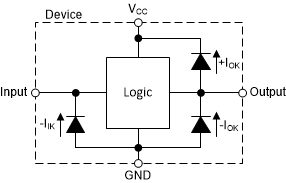ZHCSUY0 February 2024 SN74AHC157-Q1
PRODUCTION DATA
- 1
- 1 特性
- 2 应用
- 3 说明
- 4 Pin Configuration and Functions
- 5 Specifications
- 6 Parameter Measurement Information
- 7 Detailed Description
- 8 Application and Implementation
- 9 Device and Documentation Support
- 10Revision History
- 11Mechanical, Packaging, and Orderable Information
封装选项
机械数据 (封装 | 引脚)
散热焊盘机械数据 (封装 | 引脚)
- BQB|16
订购信息
7.3.4 Clamp Diode Structure
As Figure 7-3 shows, the outputs to this device have both positive and negative clamping diodes, and the inputs to this device have negative clamping diodes only.
CAUTION: Voltages beyond the values
specified in the Absolute Maximum Ratings table can cause damage to the device. The
input and output voltage ratings may be exceeded if the input and output clamp-current
ratings are observed.
 Figure 7-3 Electrical Placement of Clamping
Diodes for Each Input and Output
Figure 7-3 Electrical Placement of Clamping
Diodes for Each Input and Output